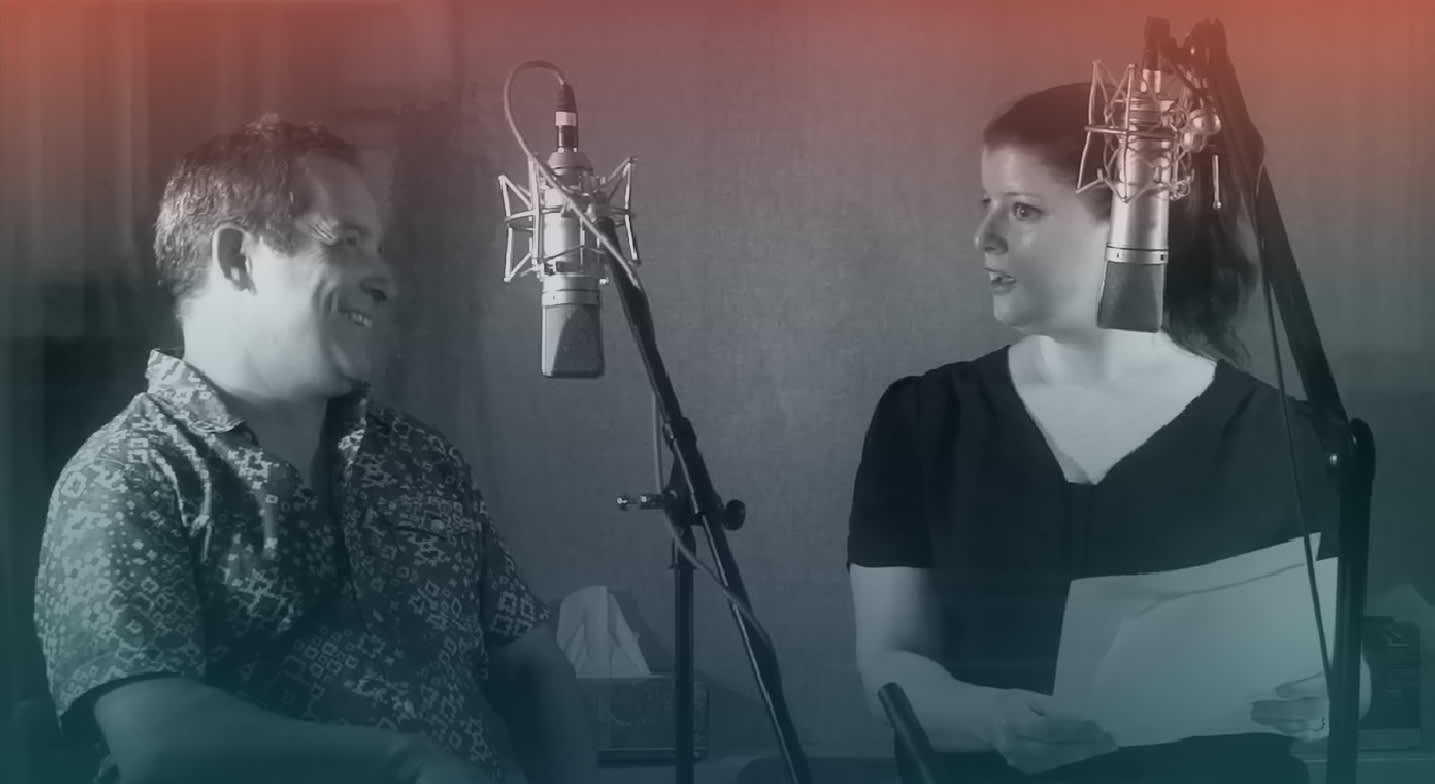The story behind the fantasy comic Nimona is magical itself: College senior Noelle Stevenson creates a whimsical story about a supervillain’s shapeshifting sidekick as part of her senior thesis, publishes her webcomic on Tumblr in 2012, and captures a devoted following, awards, and a book deal with HarperCollins. Then the graphic novel Nimona hits the shelves in 2015 and a short time later becomes a New York Times best seller and a National Book Award finalist.
Now Nimona is becoming something even more remarkable: an audiobook.
Although audiobooks have spiked in popularity, the idea of turning a visual story into an auditory one is still atypical. In comics, words and images work together symbiotically — the art conveys not only action or physical characteristics but also the more intangible spirit and tone of the story.
When Stevenson’s agent contacted her about the project, she was initially bewildered but also curious to find out what an audio version of her comic might sound like.
“I was like: huh? I wonder how they’re gonna pull that off,” the 24-year-old Maryland Institute of Comics grad says. “Comics are a visual medium, and I think in a visual way, so it was hard to predict how the adaptation was going to work. But I was very intrigued.”
So how do you translate art into sound? For the team behind the Nimona adaptation, it meant creating an audio drama, a medium that captivated millions of listeners before the advent of television. Where traditional audiobooks are recorded by a single reader who repeats the text verbatim, audio dramas — or radio plays, as they were called in an earlier era — create a far richer storytelling environment using multiple voice actors, sound effects, and music.
“It was written like a screenplay,” says Caitlin Garing, senior producer at HarperAudio. Although the dialogue remained faithful to the book, it was polished for clarity and a narrator was added to provide information that had previously been communicated through the art. Voice actor Rebecca Solerwas cast as crafty young shape-shifter Nimona, while her villainous mentor, Balister Blackheart, was voiced by Jonathan Davis.
Nimona isn’t the first time a comic has made the leap to audio. In 2015, Audible adapted the horror comic Locke & Key into an audio drama with a cast that included actors Tatiana Maslany (Orphan Black), Haley Joel Osment (The Sixth Sense, Pay It Forward), and Kate Mulgrew (Orange is the New Black, Star Trek: Voyager)
“This was one of the first times a pure graphic novel was adapted for audio, which means there wasn’t an existing script,” says Chris Delaney, the promotions manager at Audible Studios, who worked on the Locke & Key adaptation. “Between that and the rich visuals of the source material, there’s a lot of atmosphere you have to create in audio. But how do you create that atmosphere? Do you use sound design? Music? We went with a little bit of all those things.”
Although translating a comic into an audio drama means losing the visual pleasures provided by illustration, it also opens the door for new storytelling dynamics that are only possible with sound, like the nuances of a character’s tone during a tense conversation or how their voice conveys their personality.
“The coolest part for me was hearing what the actors did with the characters,” says Stevenson. “I don’t really think in ‘voices’ when I read or write so hearing it come alive like that was super neat.”
Like Nimona, the Locke & Key audio play featured a narrator, although the Audible Studios team was careful to ensure that this role supported the rest of the performances, rather than dominated them. “The goal was to avoid making it an overwhelming narrative voice,” says Delaney. “Because Locke & Key was multicast, we didn’t have just one voice tell a story. There were multiple voices, sounds, and music that all worked together to bring the listener into this world and envelop them in it.”
Garing said the most difficult moments in Nimona to adapt were the ones that relied primarily on visual information, like a page of art with no words or a visual gag that couldn’t be easily conveyed by narration alone. It was particularly tricky for a book about a shape-shifting girl who was constantly changing her appearance.
In an early scene from the graphic novel, Nimona convinces Blackheart to accept her as his sidekick by showing off her powers and appearing behind him as a toothy, talking shark. In the audio drama, we not only hear her announce the change — “I’M A SHARK!” — but also a shape-shifting sound cue that recurs throughout the audiobook. Listen to an example below:
"INSERT AUDIO HERE"

Excerpt from Nimona by Noelle Stevenson, courtesy HarperCollins/HarperAudio
“We tied a specific sound effect to her transformation and trained the listener to recognize it,” says Garing. Rather than slowing down the story with more narration, this allowed them to signal the visual change instantly so that as she transforms more frequently, the listener knows what’s going on.
The Nimona audiobook also features original music by composer Loren Toolajian, which Garing said added significantly to the dramatic atmosphere. “It was wonderful listening to the final product and realizing how much music can add to the mood and the environment. It’s really fun in the fight scenes too. One of the ways that you can play with pacing in audio is by layering in music that ramps things up or slows things down.”
The audiobook audience is not only growing but skewing younger than ever.
Ana Maria Allessi, VP of digital innovation at HarperAudio, says experiments like Nimona are part of a wider effort — which includes other audio dramas, original stories written for audio, and even audiobooks pressed on vinyl — prompted by a spike of consumer interest in audio storytelling.
“Sales have been the proverbial hockey stick,” says Allessi. “The last couple years have been tremendously robust … people want to consume more material and they’re realizing this is a really easy and satisfying way to do that.”
Audible projects that its audience will consume two billion hours of audio in 2016 alone — double the numbers from just two years earlier. The audiobook audience is not only growing but skewing younger than ever. Much as smartphones have spurred the popularity of podcasts, they’ve also enhanced the accessibility and appeal of audiobooks.
“It’s changed entirely,” says Allessi. “I have a 19-year-old daughter who came in one day and told me she needed an Audible subscription because her friends and the people she pays attention to are listening to audiobooks now. The Nimona sweet spot is going to be a 17-year-old girl. We wouldn’t have done this if we didn’t think people like that were listening.”
If enough 17-year-old girls — or people of any age and gender — download the Nimona audiobook, then more audio dramas adapted from comics could be on the horizon, as well as more experimental audio content that we might never have previously imagined.
“We need to keep moving the medium forward, because the demand is there,” says Allessi. “We can’t sit still.”





